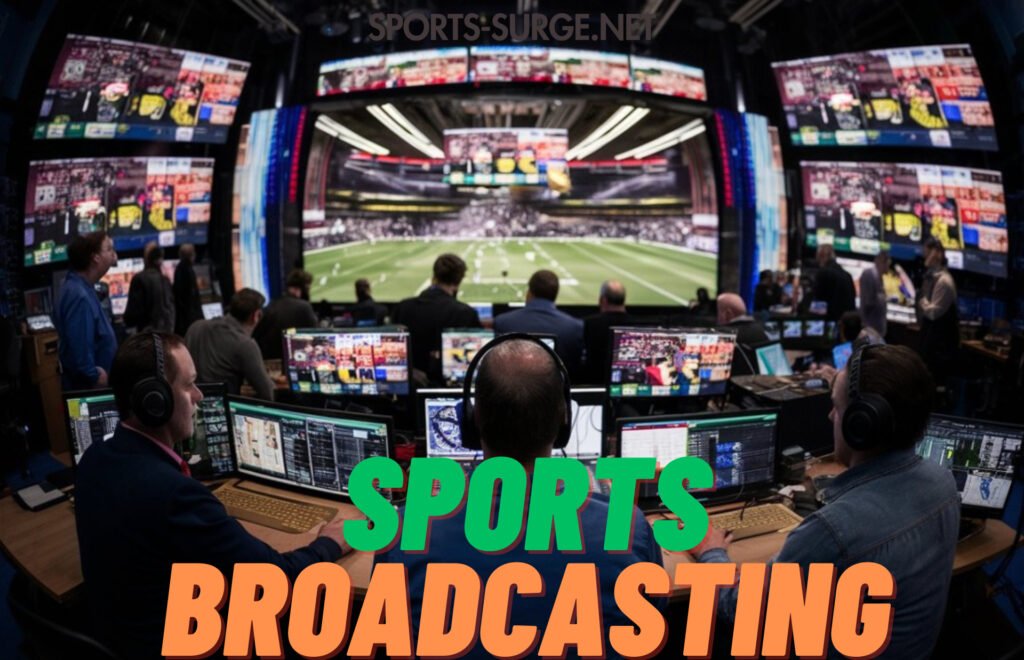Sports broadcasting, a vital component of the sports industry, has undergone a monumental transformation over the decades. From the early days of radio commentary to the present era of immersive virtual reality experiences, the journey of sports broadcasting reflects technological advancements and evolving consumer demands. As of 2024, the sports broadcasting landscape is marked by cutting-edge technologies, innovative storytelling techniques, and a focus on inclusivity and personalization. This blog explores the latest trends, challenges, and future prospects of sports broadcasting, offering insights into how it continues to reshape the way fans engage with sports.
Table of Contents
ToggleA Brief History of Sports Broadcasting

The roots of sports broadcasting can be traced back to the 1920s when radio stations began airing live commentary of baseball games in the United States. The 1930s witnessed the advent of televised sports, with the first-ever televised baseball game in 1939. Over the decades, the medium evolved, with the 1960s bringing color broadcasts and the 1980s heralding the era of cable television and dedicated sports channels like ESPN.
The internet revolution in the late 1990s and early 2000s marked a pivotal shift, enabling live streaming of sports events. By the 2010s, social media platforms had emerged as a key player in sports broadcasting, offering fans real-time updates and highlights. Fast forward to 2024, and the landscape is dominated by streaming services, 4K and 8K broadcasts, and advanced technologies like artificial intelligence (AI) and augmented reality (AR).
The Latest Trends in Sports Broadcasting
Streaming Services and OTT Platforms
Over-the-top (OTT) platforms have become a cornerstone of sports broadcasting, offering fans unparalleled flexibility and convenience. Services like ESPN+, DAZN, and Amazon Prime Video have revolutionized how sports content is consumed. In 2024, these platforms provide:
- On-Demand Content: Fans can access replays, highlights, and exclusive documentaries at their convenience.
- Global Reach: OTT platforms break geographical barriers, bringing international sports events to a global audience.
- Multi-Screen Viewing: Integration with mobile apps allows viewers to watch games on the go, making sports more accessible than ever.
AI-Powered Analytics and Commentary
Artificial intelligence is redefining sports broadcasting by enhancing both the production process and the viewing experience. AI tools analyze vast amounts of data in real-time, enabling:
- Enhanced Commentary: AI-generated insights provide viewers with in-depth analysis and statistics.
- Personalized Content: AI algorithms curate content based on individual preferences, ensuring a tailored viewing experience.
- Efficient Editing: AI automates the creation of highlight reels and recap videos, reducing production time.
Virtual and Augmented Reality
Virtual reality (VR) and augmented reality (AR) are bringing fans closer to the action. In 2024, these technologies are used to:
- Create Immersive Experiences: VR headsets allow fans to experience games from the perspective of players or as if they were sitting in the stadium.
- Enhance Broadcast Graphics: AR overlays provide real-time stats, player profiles, and tactical insights during live broadcasts.
Interactive Features
Engagement is a key focus in modern sports broadcasting. Platforms now offer:
- Live Polls and Quizzes: Fans can participate in real-time, making broadcasts more interactive.
- Social Media Integration: Viewers can share their reactions and interact with other fans through integrated social media platforms.
- Second-Screen Experiences: Apps and websites complement live broadcasts with additional data, commentary, and angles.
Sustainability and Green Broadcasting
As environmental concerns grow, sports broadcasters are adopting sustainable practices. These include:
- Remote Production: Reducing the carbon footprint by producing events from centralized locations.
- Energy-Efficient Equipment: Using renewable energy sources and energy-efficient technologies.
- Virtual Attendance: Encouraging fans to participate in events virtually, reducing travel emissions.
Challenges in Sports Broadcasting

Despite its advancements, sports broadcasting faces several challenges:
Piracy and Unauthorized Streaming
Piracy remains a major issue, with illegal streams costing the industry billions annually. Broadcasters are investing in advanced security measures, but combating piracy is an ongoing battle.
Rising Production Costs
High-definition broadcasts, sophisticated graphics, and cutting-edge technologies come at a price. Balancing quality with cost-effectiveness is a constant challenge.
Adapting to Changing Viewer Habits
The younger generation’s preference for short-form content and multi-screen viewing requires broadcasters to rethink traditional formats and adopt innovative approaches.
Inclusivity and Accessibility
Ensuring that broadcasts cater to diverse audiences, including those with disabilities, is a priority. This includes providing closed captions, sign language interpretation, and descriptive audio.
The Future of Sports Broadcasting

5G Connectivity
The rollout of 5G networks is set to revolutionize sports broadcasting by enabling:
- Seamless Live Streaming: Ultra-low latency ensures smooth viewing experiences.
- Enhanced Fan Engagement: Faster data transfer allows for real-time interaction and multi-angle viewing.
Blockchain Technology
Blockchain is being explored for its potential to:
- Combat Piracy: Decentralized platforms make unauthorized streaming harder.
- Create Unique Fan Experiences: Tokenized content and NFTs (non-fungible tokens) offer fans exclusive access to memorabilia and experiences.
Advanced AI and Machine Learning
AI will continue to evolve, offering:
- Predictive Analytics: Forecasting game outcomes and player performance.
- Emotion Recognition: Tailoring broadcasts based on audience reactions.
Globalization of Niche Sports
With the rise of OTT platforms, niche sports like eSports, kabaddi, and surfing are gaining global traction. Broadcasters are leveraging this trend to reach untapped audiences.
Hyper-Personalization
The future of sports broadcasting lies in delivering highly personalized content. This includes:
- Customized Camera Angles: Allowing viewers to choose their preferred perspectives.
- Tailored Advertising: Serving ads based on individual preferences and behavior.
Conclusion
Sports broadcasting in 2024 is a dynamic and rapidly evolving industry that continues to redefine how fans experience the thrill of the game. With technological advancements like AI, VR, and 5G, broadcasters are delivering more immersive, interactive, and personalized content than ever before. However, challenges such as piracy, rising costs, and changing viewer habits highlight the need for innovation and adaptability.
As we look to the future, sports broadcasting promises to be more inclusive, sustainable, and engaging, ensuring that fans worldwide can connect with their favorite sports in meaningful ways. Whether you’re a casual viewer or a die-hard fan, the advancements in sports broadcasting are set to offer unparalleled experiences, bringing the magic of sports to life like never before.
FAQs about Sports Broadcasting
What is sports broadcasting?
Sports broadcasting involves delivering live or recorded sports events to audiences through various media platforms, including television, radio, and the internet. It encompasses play-by-play commentary, analysis, and interviews, aiming to provide comprehensive coverage of sporting events.
How can I become a sports broadcaster?
To pursue a career in sports broadcasting, consider the following steps:
- Education: Obtain a degree in journalism, communications, or a related field.
- Experience: Gain practical experience through internships, college radio/TV stations, or online platforms.
- Networking: Build connections within the industry to learn about opportunities and gain insights.
- Skill Development: Hone your public speaking, writing, and analytical skills.
Continuous learning and adaptability are crucial in this evolving field.
What skills are essential for a successful sports broadcaster?
Key skills include:
- Communication: Clear and engaging delivery of information.
- Research: In-depth knowledge of sports, teams, and players.
- Adaptability: Ability to think quickly and react to live events.
- Technical Proficiency: Familiarity with broadcasting equipment and software.
- Interpersonal Skills: Effective interaction with athletes, coaches, and colleagues.
These competencies enable broadcasters to deliver insightful and engaging content.
What is the average salary for a sports broadcaster?
Salaries vary based on experience, location, and the employing organization. In the United States, sports broadcasters can earn between $45,000 and $125,000 annually. Top professionals in major markets or national networks may earn higher salaries.
How has technology impacted sports broadcasting?
Technological advancements have significantly transformed sports broadcasting by:
- Enhancing Viewer Experience: High-definition visuals, augmented reality graphics, and multiple camera angles.
- Expanding Accessibility: Streaming services and mobile platforms allow audiences to watch events live from anywhere.
- Improving Analysis: Advanced statistics and real-time data provide deeper insights during broadcasts.
These innovations have made sports broadcasting more dynamic and interactive.
What are the challenges faced by sports broadcasters?
Challenges include:
- Maintaining Objectivity: Providing unbiased commentary.
- Handling Live Broadcasts: Managing unexpected events or technical issues in real-time.
- Keeping Up with Industry Changes: Adapting to new technologies and evolving viewer preferences.
- Work-Life Balance: Managing irregular hours, including nights and weekends, especially during live events.
Addressing these challenges requires resilience, continuous learning, and a passion for sports.

